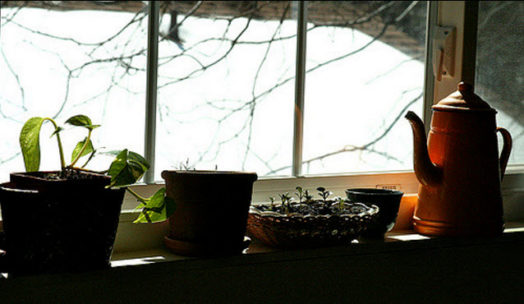In the past few months, I’ve found that I’ve got a little bit of Emeril in me—not only am I loving to cook, but I’ve been having fun experimenting with different recipes and seasonings (and screaming bam! to myself, alone in my apartment—I swear it adds flavor). Nothing tastes more fresh than a homemade Caprese salad sprinkled with fresh basil, but it’s quickly becoming an indulgent luxury as buying fresh herbs puts a decent dent in my grocery money. It’s not that they’re all that expensive, but I buy a whole pack of fresh basil and can never use it up in time before it’s no good. So, I decided to invest in an indoor herb garden, and research a bit about how to grow healthy plants when my kitchen window happens to face an alleyway rather than a radiant lake view. Here’s what I’ve found:
Indoor gardens are a great addition to any kitchen. They’re easy, cheap, and you have full control over how you decide to grow them. Anything from basil, parsley, oregano, sage, thyme, and rosemary can all be grown indoors as a part of your garden. If you decide to invest, there are two ways to get your garden going. If you have a bright, south-facing window (so the plants won’t burn) that gets about 6-8 hours of light a day, you can buy some culinary herb seeds, potting soil, and get to it. If you’re windows don’t quite match up to these grow standards, buy an herb-growing kit (anywhere from $5-$50) that comes with seeds and planters, and invest in some grow lights.
Here are some tips to keep your plants alive and healthy:
- 60-70 degrees F is the optimal temperature for indoor gardens.
- If you notice insects and invasive bugs hovering around your plant, just grab a spray bottle, fill it with soapy water, and spray away, being sure to get the underside of leaves where eggs usually hatch.
- Don’t crowd your plants, as they need air circulation to thrive. Most seed packets should have some spacing instructions.
- Turn your plants every once in while to keep them growing evenly on both sides.
- Water regularly according to instructions, making sure to drain the plants properly so they do not sit in excess water and begin to rot.
- Wait until your plant is about six to eight inches before snipping their leaves. Don’t take anymore than a quarter of the plant at a time, and make sure it re-grows before harvesting again.
- With the plants right on your windowsill, they’re easy to manage, fun to watch grow, and reap tasty rewards.
Anyone else have any tips for an indoor herb garden?

